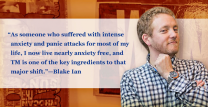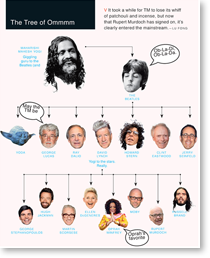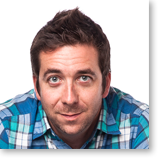 In the September issue of GQ magazine article about the Transcendental Meditation technique leads with this teaser:
In the September issue of GQ magazine article about the Transcendental Meditation technique leads with this teaser:
“The most successful, innovative men alive do it. Overworked, very, very busy hedge-fund managers swear by it.” So, writer Josh Dean asks, should you close your eyes for 20 minutes twice a day and join in? Will it work even if you’re skeptical?”
Here are some more excerpts from Mr. Dean’s charming article which seeks to provide an answer to this important question:
The most successful, innovative men alive do it. Overworked, very, very busy (and insanely rich) hedge-fund managers swear by it. So the question is: Should you cross your legs, close your eyes, and join in?
Here are a few things Jerry Seinfeld and I have in common: We both wear sneakers far more often than grown men should. We both adore the New York Mets and thus subject ourselves to undue misery. And we both sit quietly for twenty minutes twice a day, attempting to calm our minds. Seinfeld, presumably, is far better at it than I am. He’s been practicing Transcendental Meditation, or TM, for more than forty years. I’ve only recently taken it up.
Transcendental Meditation, if you’re not aware, is having something of a moment. Despite being 5,000 years old and in the public consciousness at least since 1968 (when the Beatles traveled to India, took up meditating, and were so mind-blown that they wrote the White Album), TM spent most of the past half century out on the hippie fringe. If people thought anything about it, it was that TM was weird and maybe kind of cultish. But a dedicated core of reasonable people have been practicing it all along, and their ranks keep swelling, so TM is now following the path of yoga—another import from India, once marginalized as a trifle for tempeh enthusiasts—into the mainstream, where it can safely be sampled by even self-conscious, risk-averse people like me.
“You know how your phone has a charger?” Seinfeld said last year, during an appearance on Good Morning America. “TM is like having a charger for your mind and body.” Russell Brand, who says TM helped him stay sober, calls it “a shower for your brain.” And gray-pompadoured film director David Lynch—whose eponymous foundation is the driving force behind the recent boom in the popularity of TM in America, converting everyone from Oprah to Rupert Murdoch—says that his twice-daily meditations give him “effortless access to unlimited reserves of energy, creativity, and happiness deep within.”
But the name that jumped out most when I started looking at TM’s fans was Ray Dalio, founder and chairman of Bridgewater, the world’s largest hedge fund. Dalio is a superhero of the financial world. And what the 63-year-old has to say about TM—which he started doing forty years ago, in college—is not ambiguous: “I think meditation has been the single biggest reason for whatever success I’ve had.” This from the thirty-third-richest man in America.
Over nearly forty years of living, I’d never once given meditation even the slightest consideration. Though I’m very liberal and (I think) pretty open-minded, it always seemed way too hippie-dippy and, to a guy who struggles to sit still, like a form of torture. But these weren’t the names of weirdoes. And Ray Dalio is hardly the kind of guy who’d waste forty minutes of every day for forty years on a fad. I decided to kick TM’s tires.
“If you’re skeptical, fabulous! You should be. I was skeptical.” This is Bob Roth talking. Roth is the executive director of the David Lynch Foundation, and my TM teacher. He is a tall, slender man with charcoal-colored hair and, at least in April, a healthy tan; he bears a slight resemblance to George Plimpton, but with flashier teeth. Roth has been practicing TM for forty-four years and teaching it for forty-one. He took it up at the suggestion of a close friend but says that his initial reaction was to recoil because of TM’s flower-power-y taint. “The thing I asked my teacher was, how much of this do I have to believe in for it to work? He said you can be 100 percent skeptical and it’ll still work.” Roth is generous with his smiles, and he shot me a big one. “The cool thing about this is you don’t have to believe in anything. There’s no philosophy.”
Other forms of meditation require a far greater commitment and can be more difficult to adopt. They teach either extreme concentration (an intense focus on one particular thing, and only that thing) or contemplation (thinking as hard as you can about the present, which is often referred to as mindfulness), but what makes TM so user-friendly is that you don’t have to do either. It’s easy—“effortless,” as Roth is fond of saying.
Roth was scheduled to run across midtown Manhattan to talk to a hedge fund whose founder wished to introduce the concept to his employees, and I asked if I could tag along. Nigol Koulajian, 46, is the founder of Quest Partners, an $850 million hedge fund. He was exactly the kind of person I most wanted to meet—a successful entrepreneur in a very conservative business that doesn’t exactly encourage deviation from the norm. So why does he do it?
Koulajian works out and does yoga, but he later told me that TM is the most important piece of his wellness regime: “I do it every day, no matter what. I feel like if I don’t do it, then something in my actions that day will not be of the same quality.”
He said that he’s come, over two decades of working in finance, to see that most people are afraid to think independently, and follow their instincts. Instead, their decisions are based too much on external influences. “When you do that, you don’t have your own sense and convictions,” he said. “TM has given me some sense of what my real inner feeling is about something. If I wasn’t practicing, I’d just be going along with the crowd.”
I learned to meditate on an overstuffed lounge chair in an otherwise bare interior office that might also have been an old closet in its previous life. I’d imagined my TM lessons would be held someplace better smelling and more womblike, the kind of place that would encourage peaceful inward thinking. But one of the primary selling points of TM is that it’s easy to learn and practice. Once you’ve learned, Roth says, you can do it in a taxi. (And he has.)
“In TM, we learn how to give the attention of the mind an inward direction rather than out there,” Roth said. “It’s like teaching a child how to dive: Take the correct angle and the rest is automatic. You don’t have to say, ‘Don’t stop.’ It’s just gravity.”
If TM is the one form of meditation that has successfully gone mainstream, the reason is that it seems to work. And the science backs that up. To date, there have been more than 340 research studies into the benefits, and one of the David Lynch Foundation’s primary goals is taking those benefits to people who need them most—prisoners, victims of abuse, war veterans, underprivileged children.
The most tangible result of practicing TM is the way it reduces stress. If the only thing it did was cause you to sit quietly with your eyes closed, this would reduce stress in your life, providing a forced break from the furious fire hose of data and stimulation blasting you on a second-by-second basis. But TM’s effect appears to be far more powerful than that. Some psychologists have taken to calling stress the “Black Plague of the twenty-first century,” because it is a runaway condition with no obvious cure. Stress causes inflammation, weakens the immune system, and is a risk factor for all kinds of serious health problems, from heart disease to depression. TM has, over many studies, helped cut stress and lower blood pressure. It has been shown to ease depression, curb violent impulses, and lessen symptoms of ADD and ADHD. It has even, as the TM adherent Dr. Mehmet Oz pointed out, been found to reduce skin lesions in some patients.
Stress also affects the prefrontal cortex, home of the higher brain and the source of what is sometimes called executive function; here lie judgment and problem solving. Being stressed can cause us to make poor decisions, and being under stress is a given of doing business. The power of TM, it seems, is in teaching the brain to maintain what Ray Dalio, king of the hedge-fund world, calls a “calm, clearheaded state.” He says that mastering TM made him feel “like a ninja,” so that problems come at him in slow motion.
Bob Roth is of the belief that TM taps an inner calm we all have, a calm that gives the brain a chance to settle and repair its frazzled neurons. During our first classes, he was quick to point out that newbie meditators can’t expect to achieve some perfect transcendent state. Distracting thoughts occur and are expected, and you need not try to push them out. They are the manifestation of the brain shedding stress, he says, and they’re just part of the process.
“The hypothesis—and I love to tell people that you don’t have to believe in it—is that every single human being has a level deep inside the mind that’s already calm,” Roth said. “It was that way yesterday, it’s there now, and it will be there tomorrow. Everybody—the kid in the inner-city school, the skeptic working on a hedge fund—everybody’s got that. We’ve just lost access.”
The thing everyone asks you, when you share the news you’ve taken up meditating, is: Does it work? My wife in particular liked to ask me this, and I tended to tell her one of these things: I think. I’m not sure. I can’t tell. The honest truth is that this is a very hard question to answer. (She also laughs at me—still!—every time I tell her I’m going to meditate.)
The question I was asking two months after my first session, when I went for a follow-up, was about the mixed quality of my meditations. Sometimes, when my mind is most at ease, and not preoccupied by thoughts—especially the annoying meta-thoughts, such as “I wonder how much time is left?”—the time flies by. TM can be like a tour through your subconscious, and in twenty minutes you can cover a lot of ground traipsing past the various things agitating your psyche. It can also be trippy, and I am sometimes startled to find myself a few minutes into a lucid dream.
Other times, I struggle greatly. Then, time crawls. I’ve taken some relief in Ray Dalio’s experience. He says that it took him “a while, probably months,” to get past meditations that were basically a tennis match between conscious thoughts and the mantra to a point “where I could clear my mind of thoughts and start transcending.”
Despite the fact that Roth had told me, repeatedly, not to use the mantra as a club with which to bat away thoughts, I admitted that at times I was doing exactly that. And the worst part was that I was quick to observe myself doing this, and this would immediately cause me to commence thinking about all the ways I was doing it wrong.
Roth stared at me with no expression. “Are you enjoying it?
Do you generally feel good after?”I said that I did, nearly always.
”Then don’t worry about it. This should be simple. It’s not like it only works if you do it, absolutely and without fail, for twenty minutes twice a day.” Roth was, as good teachers are, gentle and reassuring without taking himself or the subject too seriously.
There’s an old saw about golf—that it takes only one great shot in an otherwise awful round to keep you coming back—and similarly, the meditations that work best, that feel easy and pass quickly, make you want to keep going. And those in particular do seem to provide more tangible benefits, in particular a more restful and focused mind. I am finding myself able to concentrate more fully on the task at hand, to better adjust the volume on distracting background noise. Now, I still haven’t reached the ninja realms of Ray Dalio and David Lynch, and I’m skeptical that I ever will—I can’t help myself. But that hasn’t kept me from closing my eyes every day [and meditating].
© 2013 by GQ Magazine
———————————————
Josh Dean has written for GQ, Outside, and Rolling Stone.






